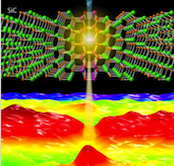
Breakthrough research made possible by advanced microscopic techniques
Irvine, Calif., Jan. 11, 2021 – Often admired for their flawless appearance to the naked eye, crystals can have defects at the nanometer scale, and these imperfections may affect the thermal and heat transport properties of crystalline materials used in a variety of high-technology devices.
Employing newly developed electron microscopy techniques, researchers at the University of California, Irvine and other institutions have, for the first time, measured the spectra of phonons – quantum mechanical vibrations in a lattice – at individual crystalline faults, and they discovered the propagation of phonons near the flaws. The team’s findings are the subject of a study published recently in Nature.
“Point defects, dislocations, stacking faults and grain boundaries are often found in crystalline materials, and these defects can have a significant impact on a substance’s thermal conductivity and thermoelectric performance,” said senior co-author Xiaoqing Pan, UCI’s Henry Samueli Endowed Chair in Engineering, as well as a professor of materials science and engineering and physics & astronomy.
He said that there are ample theories to explain the interactions between crystal imperfections and phonons but little experimental validation due to the inability of earlier methods to view the phenomena at high enough space and momentum resolution. Pan and his collaborators approached the problem through the novel development of space- and momentum-resolved vibrational spectroscopy in a transmission electron microscope at UCI’s Irvine Materials Research Institute.
With this technique, they were able to observe individual defects in cubic silicon carbide, a material with a wide range of applications in electronic devices. Pan and his colleagues were familiar with how imperfections in silicon carbide are manifested as stacking faults, and theoretical work has described the thermoelectric impacts, but now the team has produced direct experimental data to characterize phonon interactions with the individual defects.
“Our method opens up the possibility of studying the local vibrational modes at intrinsic and non-intrinsic defects in materials,” said Pan, who is also director of IMRI and UCI’s Center for Complex and Active Materials, funded by the National Science Foundation. “We expect it to find important applications in many different areas, ranging from the study of thermal resistance-inducing interfacial phonons to defect structures engineered to optimize a material’s thermal properties.”
This project, which was supported by the U.S. Department of Energy’s Office of Basic Energy Sciences and the NSF, included researchers from Nion R&D in Kirkland, Washington; China’s Henan University; and Cornell University.
About the University of California, Irvine: Founded in 1965, UCI is the youngest member of the prestigious Association of American Universities. The campus has produced three Nobel laureates and is known for its academic achievement, premier research, innovation and anteater mascot. Led by Chancellor Howard Gillman, UCI has more than 36,000 students and offers 222 degree programs. It’s located in one of the world’s safest and most economically vibrant communities and is Orange County’s second-largest employer, contributing $5 billion annually to the local economy. For more on UCI, visit www.uci.edu.
UCI News
